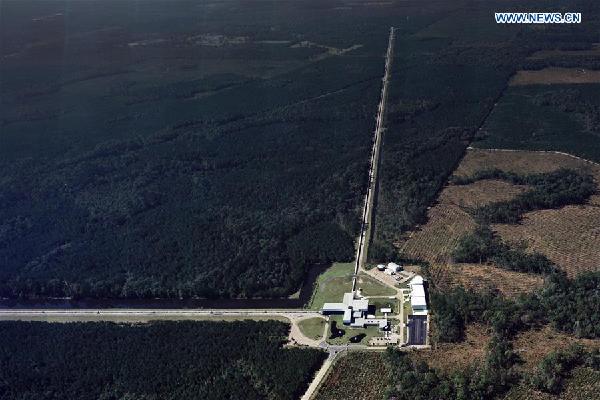


File photo shows the Laser Interferometer Gravitational-wave Observatory (LIGO) in Livingston, Louisiana, the United States. U.S. scientists said Thursday they have detected the existence of gravitational waves, which were predicted by Albert Einstein's theory of general relativity 100 years ago. (Xinhua Photo)
WASHINGTON, Feb. 11-- In a historic announcement, scientists said Thursday they have for the first time directly detected the existence of gravitational waves, which were predicted 100 years ago by Albert Einstein's theory of general relativity, one of the two pillars of modern physics.
SCIENTIFIC MOONSHOT
"Ladies and gentlemen, we have detected gravitational waves," declared David Reitze, executive director of the U.S.-based Laser Interferometer Gravitational-wave Observatory (LIGO), during a news conference Thursday in Washington, D.C.
"We did it," Reitze said, drawing a standing ovation. "This was truly a scientific moonshot. I really believe that. And we did it. We landed on the moon."
The detected gravitational waves were produced during the final fraction of a second of the merger of two black holes to produce a single, more massive spinning black hole. This collision of two black holes had been predicted but never observed.
The gravitational waves were detected on Sept. 14, 2015, at 5:51 a.m. EDT (0951 GMT) by both of the twin LIGO detectors, located in Livingston, Louisiana; and Hanford, Washington.
Based on the observed signals, LIGO scientists estimated that the black holes for this event were about 29 and 36 times the mass of the Sun, and the event took place 1.3 billion years ago.
About three times the mass of the Sun was converted into gravitational waves in a fraction of a second -- with a peak power output about 50 times that of the whole visible universe.
FULFILL EINSTEIN's LEGACY
In 1916, German-born theoretical physicist Einstein predicted the existence of gravitational waves, or ripples in the fabric of spacetime resulting from the most violent phenomena in our distant universe such as supernovae explosions or colliding black holes.
Gravitational waves were the last piece of Einstein's theory of general relativity that have yet to be proven. Signals from gravitational waves are so weak that Einstein himself questioned whether a device sensitive enough could be developed to capture this phenomenon.
In 1974, two American scientists discovered a binary pulsar, a pair of two dead stars emitting pulses of radio waves. They later realized that the orbit of the pulsar was slowly shrinking over time because of the release of energy in a way Einstein's theory predicted: gravitational waves.
For discovering the pulsar and indirectly confirming the existence of gravitational waves, the two were awarded the 1993 Nobel Prize in Physics.
The new LIGO discovery was the first observation of gravitational waves themselves, made by measuring the tiny disturbances the waves made to space and time as they passed through the earth.
"Our observation of gravitational waves accomplishes an ambitious goal set out over five decades ago to directly detect this elusive phenomenon and better understand the universe, and, fittingly, fulfills Einstein's legacy on the 100th anniversary of his general theory of relativity," said Reitze.
"It would have been wonderful to watch Einstein's face had we been able to tell him," added Rainer Weiss, professor of physics from the Massachusetts Institute of Technology, who proposed LIGO as a means of detecting gravitational waves in the 1980s, along with Kip Thorne and Ronald Drever of the California Institute of Technology.
NEW ERA
The new discovery, accepted for publication in the journal Physical Review Letters, was made by the LIGO Scientific Collaboration (LSC), a group of more than 1,000 scientists from universities around the United Statesas well as in 14 other countries.
Rumors about the LIGO discovery have been circulating for months in the world of physics, prompted by Twitter posts by Lawrence Krauss, a theoretical physicist at the Arizona State University, who was not part of the LIGO team.
Krauss described in an email to Xinhua Thursday the finding as "a huge milestone."
"It opens a new window on the universe, like the invention of the telescope or discovery of radio waves from space," he said. "Gravitational wave astronomy will be the astronomy of the 21st century."
Gabriela Gonzalez, LSC spokesperson and professor of physics and astronomy at the Louisiana State University, echoed the same view, saying: "This detection is the beginning of a new era: The field of gravitational wave astronomy is now a reality."
"With this discovery, we humans are embarking on a marvelous new quest: the quest to explore the warped side of the universe -- objects and phenomena that are made from warped spacetime," added Thorne. "Colliding black holes and gravitational waves are our first beautiful examples."
 Have you ever taken these beautiful subways in China?
Have you ever taken these beautiful subways in China? Chinese beauties, foreign models meet in Chengdu
Chinese beauties, foreign models meet in Chengdu Awesome! Aerial pictures taken on J-11 fighter
Awesome! Aerial pictures taken on J-11 fighter A foreign girl explains what China should be proud of
A foreign girl explains what China should be proud of Chinese navy's air-cushioned landing craft in pictures
Chinese navy's air-cushioned landing craft in pictures Chinese pole dancing master opens class in Tianjin
Chinese pole dancing master opens class in Tianjin Splendid Sichuan after snow
Splendid Sichuan after snow College girl of Vancouver crowned Miss Chinese Int'l 2016
College girl of Vancouver crowned Miss Chinese Int'l 2016 Pentagonal Mart becomes the largest vacant building in Shanghai
Pentagonal Mart becomes the largest vacant building in Shanghai Top 20 hottest women in the world in 2014
Top 20 hottest women in the world in 2014 Top 10 hardest languages to learn
Top 10 hardest languages to learn 10 Chinese female stars with most beautiful faces
10 Chinese female stars with most beautiful faces China’s Top 10 Unique Bridges, Highways and Roads
China’s Top 10 Unique Bridges, Highways and Roads After spate of espionage allegations, US law firm opens first China office
After spate of espionage allegations, US law firm opens first China office Author Feng Tang attacks decision to pull book from shelves
Author Feng Tang attacks decision to pull book from shelves Going ape for New Year
Going ape for New Year Black lungs
Black lungsDay|Week